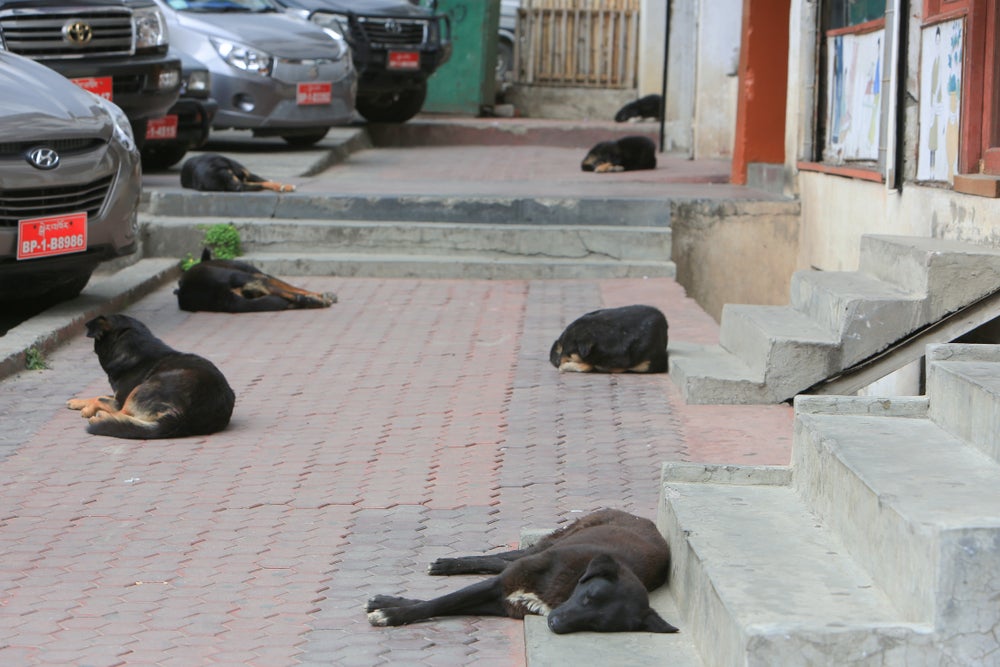 Morning pigeon patrol. Photo: David Mason/World Bank
Morning pigeon patrol. Photo: David Mason/World Bank
Twenty years ago, the Bahamian musical group Baha Men released a Grammy award-winning song which posed a rhetorical question: “Who let the dogs out?”
First-time visitors to Bhutan’s capital city may find themselves asking the same question when they notice the conspicuous presence of dogs wandering about Thimphu.
Bhutan has around 735,000 people, and the country’s dog population is about one third that number.
Thimphu’s centrally-located Clock Tower Square is a favored spot for these noisy canine raconteurs, especially in the hours after 1:00 a.m.
The concentration of man’s best friends in Bhutan’s city centers should come as no surprise.
Since 2000, the country has seen expansive changes in living standards and a more prominent role of cities in the economy.
But as Bhutan's cities develop fast, so does its stray dog population, who subsist on discarded meat waste and food handouts from local communities.
Bhutan is South Asia’s most rapidly urbanizing country- with a growth rate of 5.7 percent per year.
As of 2017, 37.9 percent of Bhutan’s total population lived in urban areas.
The country has reduced its share of extreme poverty from 17 percent in 2003 to 1.5 percent in 2017 as it transitioned to a service economy, away from subsistence agriculture. It has also more than tripled its per capita gross domestic income from $770 in 2000 to $2,660 in 2018.
As a result, Bhutan’s main cities, Thimphu and Phuentsholing, have become magnets for job seekers looking to gain from the opportunities and lifestyle these urban centers offer.
On an evening in May, just south of downtown Thimphu, people gather at the noisy bus station, a hive of activity where local cabs huddle for fares while long-distance vans and buses huff in to the drop off area carrying weary passengers after day-long journeys from eastern settlements of Mongar and Tashigang.

Migrants moving to urbanized regions from the rural east have put immense pressure on Bhutan’s four municipalities to provide reliable urban services such as piped water, trash pick-up, and local bus transportation.
The World Bank’s recent Bhutan Urban Policy Notes looks at the progress and ongoing challenges in four critical areas for Bhutanese cities.
Consequently, data systems need to be improved to assess better the threats from flooding, earthquakes, and other risks. This will allow residents and businesses to be more aware of what they face and can respond accordingly.
The increased concentration of people and buildings in urban centers has raised the risk potential for more considerable damage and loss of life in the event of a natural disaster.
Furthermore, local city governments should integrate this information into their planning systems and building retrofitting efforts. Municipalities will also need to play a more significant role in service delivery and require improvements in capacity, revenue collection capability and planning and managing budgets.
Bhutan’s deepening urban environmental problems demand attention too.
For example, Thimphu only treats about 17 percent of its wastewater; the rest of it flows directly into the Thimphu River. The river also receives leakage of waste from the overtaxed Memelakha landfill, further degrading the quality water and reducing its use for human consumption downstream.
As it kickstarts its ambitious 12th Five Year Plan, the government has shown a clear interest in addressing these critical challenges to Bhutan’s development.
The goal now is to make good on that promise to keep cities clean, competitive, and inclusive—even for its four-legged residents.


Join the Conversation